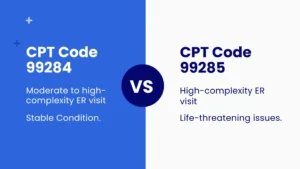Chronic Obstructive Pulmonary Disease (COPD) is a persistent disease of the lung that has been a major concern for healthcare practitioners and hospitals, and is a major concern in the medical field. The International Classification of Diseases has a code for the disease under chronic obstructive pulmonary disease (ICD 10), which, for that matter, is perhaps one of the most universal codes used in modern medicine.
Another prevalent diagnosis in current use is J44.9, which denotes a broad diagnosis of COPD without any further details or complicating factors. While this code most certainly fulfills its purpose, it is one of the most overused codes to date. In this article, we will discuss the appropriate use of the above-mentioned code as well as instances that suggest this code may not be the most suitable option.
What Does J44.9 Mean?
“ICD-10 Code J44.9 – Chronic Obstructive Pulmonary Disease, unspecified”. This code refers to chronic obstructive pulmonary disease that is not specified or has no other symptoms. It comes under the umbrella ICD 10 for COPD. This specific code is allocated when the diagnosis provided is COPD. As such, it does not specify what type, nor do the clinical notes indicate whether the disease is active, stable, or has been deteriorating.
More simply, the mentioned code serves best in situations where the details are not present, but not useful when details and specifics are provided. However, in medical cases, where the patient’s history is scant or absent, this code will help to document the patient’s condition without any delay.
When Should You Use J44.9?
Situations such as these would require this code to be valid:
· When the patient has a stable history and doesn’t have any new symptoms of chronic disease.
· Enumerated under the chronic conditions of the patient, only COPD is listed; nothing additional is noted.
· The visit does not fall under respiratory concerns, and there are no current lung concerns.
· Might be utilized in cases when a patient with chronic obstructive airways disease ICD 10 is not having an exacerbation or infection during that visit. This is especially commonly used in routine checkups, preoperative assessments, or non-respiratory specialty consultations where the COPD diagnosis is noted, but not the primary focus of the visit.
When Not to Use This Code
· If your patient is experiencing an exacerbation, you need to specify something more precise. Like the Strengthening of symptoms like increased coughing, short breathing, or wheezing is a strong indicator for acute COPD exacerbation, ICD 10.
· For that case, in place of using the short code, it is good to consider the more precise ICD 10 code for COPD exacerbation. Most likely, the correct answer is J44.1, which is indicated for exacerbation of COPD without infection.
· Involvement in infection, such as bronchitis or pneumonia, can use code J44.0, which may be more accurate in this case. Those situations remain within the domain of the ICD 10 code for chronic obstructive pulmonary disease, but are divided differently.
Why COPD Coding Accuracy Counts
Accuracy of COPD coding is relevant for multiple reasons.
· Customer service representatives (CSRs) will more or less accept a claim depending on which COPD code was submitted.
· Insurers might also cut losses and decline payment for other services rendered based on the submitted claim.
· Coding will affect certain treatment algorithms or management plans set in place on a patient’s record.
· It contributes in some way to calculating a patient’s risk profile.
· Care decisions may be unfavorable if patients are considered more stable under the overuse of this application of code.
· Lastly, high-quality coding improves tracking of population respiratory disease epidemics. Accurate documentation impacts resource allocation and research initiatives into COPD because data validity relies on the accuracy of medical documentation.
Accurate coding not only impacts COPD claims but also applies to cardiopulmonary procedures like echocardiograms. Learn more about CPT code 93306 here.
Aiding Illustrative Examples
Consider two distinct scenarios for clarification.
Scenario One
A 67-year-old male (Mr. Smith) walks in on time and unaccompanied for a regular blood pressure check. He has a past history of chronic obstructive lung disease ICD 10 but denies current respiratory symptoms on ROS. Stable COPD, no issues today, is what your chart notes say. In this case, J44.9 might accurately describe this encounter.
Scenario Two
A 72-year-old female (call her Ms. Jones) calls stating persistent coughing with more frequent shortness of breath. She has started on a new steroid inhaler with a dosing adjustment to step-up therapy. This is an exacerbation. Under this scenario, the best choice would be the COPD exacerbation ICD 10 code.
What About CPAP and Sleep Apnea?
If your patient with COPD is also undergoing CPAP therapy, keep in mind that CPAP ICD 10 entries are distinct. These typically connect with sleep apnea or chronic respiratory failure. While it might show under the same patient profile, CPAP treatment does not alter the COPD diagnosis.
It’s important, on the other hand, to identify both conditions together. This improves the treatment strategy and helps in the reimbursement process.
How to Improve Your Coding Practice
Below are some suggestions that can assist you and your team in improving your coding:
Document Details Accurately
Indicate clearly if the patient is stable, deteriorating, or currently infected. If at the time of checkup any symptoms are present, note them correctly in the documents.
Regular Updates of Diagnoses Keep Your Records Current
Ensure you are actively updating your COPD codes. Updates must be made after conditions are assessed.
Encourage Use of Specific Codes
This code should not be used for convenience. Ensure to check the entire list of COPD-related codes to identify the most accurate match.
Encourage Training of Support Staff
Assistant and coding personnel must understand the clinical notes and know how to translate them into their ICD codes.
Check Notes Before the Last Review
If your EHR suggests putting this code, re-read the information presented. You might find amore precise code related to your patient condition.
Final Thoughts
As the saying goes, beware of one who practices a single trade; COPD is multifaceted, and so its coding should be also. The chronic obstructive airways disease ICD-10 and chronic obstructive lung disease ICD 10 both have their respective purposes and are used for different conditions. While J44.9 may suit best when little information is provided, it is not advisable to use it as a primary fallback.
Achieving the proper coding facilitates proper care, efficient tracking of processes, and equitable reimbursement. Clinicians are able to provide appropriate codes more confidently with clear documentation and proper knowledge of the ICD-10 system.




